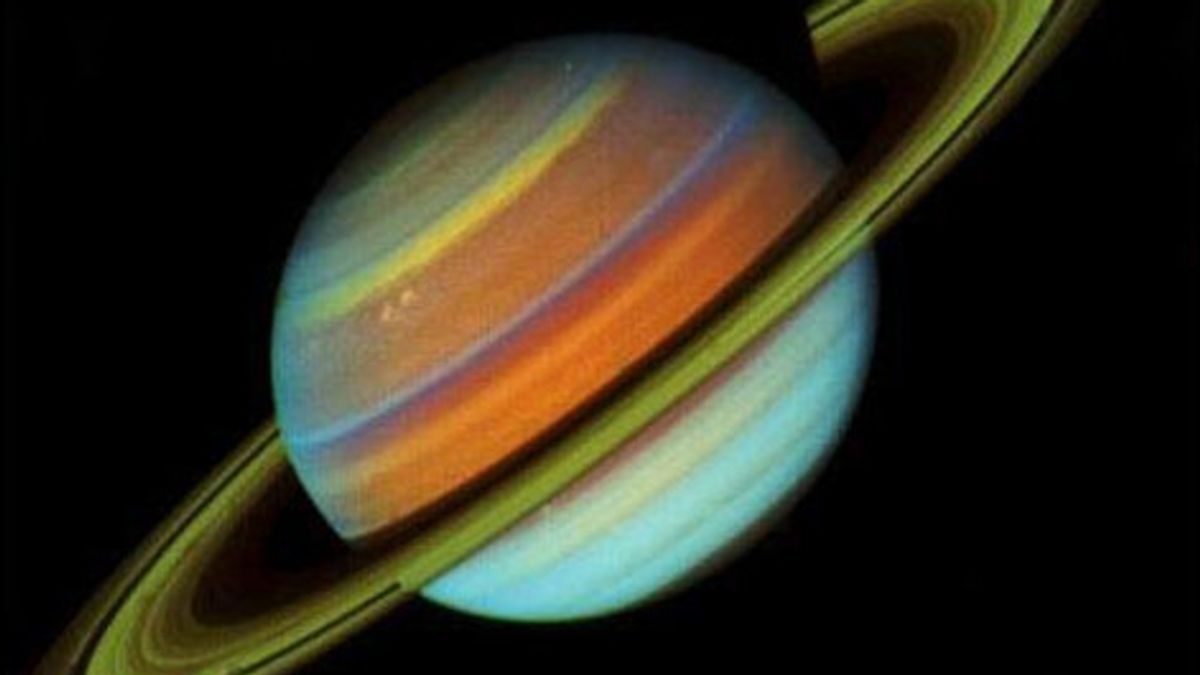JAKARTA - Astronomers now find a ring in Saturn that looks luxurious and can be easily observed, not as calm as it seems. Because hail of ice particles affects the weather of the giant planet.
"This phenomenon has never been seen before in the Solar System. It is an unexpected interaction between Saturn and its defenses that has the potential to provide a tool to predict whether other planets around other stars also have Saturn-like ring systems," NASA said.
Armed with observational data from NASA and ESA's Hubble Space Telescope, Voyager 1 and 2, the Cassini probe and the retired International Ultraviolet Explorer mission to bring it all together.
As a result, astronomers discovered an excess of ultraviolet radiation, seen as a hot hydrogen spectral line in Saturn's atmosphere. This means that the radiation pollutes and heats the upper atmosphere from the outside.
"The most plausible explanation is that ice ring particles that shower Saturn's atmosphere cause this warm-up. It could be due to the impact of micrometeorites, the bombardment of solar wind particles, solar ultraviolet radiation, or the electromagnetic force that takes electrically charged dust," NASA said.
"All of this happened under the influence of Saturn's gravitational field which attracted particles to the planet," he continued.
NASA's Cassini spacecraft had previously measured Saturn's atmospheric constituents in 2017 as it fell into the planet's atmosphere and confirmed that many particles fell from the ring.
"Everything is driven by ring particles flowing into the atmosphere at certain latitudes. They modify the upper atmosphere, changing composition," said study co-author Lotfi Ben-Jaffel of the Institute of Astrophysics in Paris and the Lunar & Planetary Laboratory, University of Arizona.
"And then you also have a collision process with atmospheric gases that might heat up the atmosphere at some altitude," he added.
Astronomers suspect processes involving particle collisions with atmospheric gases are most likely heating the atmosphere at certain heights, as quoted by Metro, Monday, April 3.
In the study, astronomers gathered observations of the Ultraviolet-Light (UV) archive of four space missions studying Saturn. Including observations of two Voyager rides flying past Saturn in the 1980s and measuring UV excess.
"When everything is calibrated, we clearly see that the spectrum is consistent on all missions. This is possible because we have the same reference point, from Hubble, at the energy transfer rate from the measured atmosphere for decades," said Ben-Jaffel.
"It was really a surprise for me. I just splotted different light distribution data, and then I realized, wow it's the same," he added.
UV data for four decades covers many solar cycles and helps astronomers learn the seasonal effects of the Sun in Saturn. By unifying all the diverse data and calibrating it, Ben-Jaffel found no difference in the level of UV radiation.
"Whenever, in any position on the planet, we can follow the UV radiation level," explained Ben-Jaffel.
This shows stable hail from Saturn's ring as the best explanation, "We have just started the characterization of this ring in the upper atmosphere of a planet. We finally want to have a global approach that will produce tangible features of the atmosphere in a distant world," said Ben-Jaffel.
One of the goals of this study is to see how astronomers can apply it to planets orbiting other stars. Call it searches for exo-rings. The results of the study were published in a paper published on March 30, 2023 in the Planetary Science Journal.
The English, Chinese, Japanese, Arabic, and French versions are automatically generated by the AI. So there may still be inaccuracies in translating, please always see Indonesian as our main language. (system supported by DigitalSiber.id)













